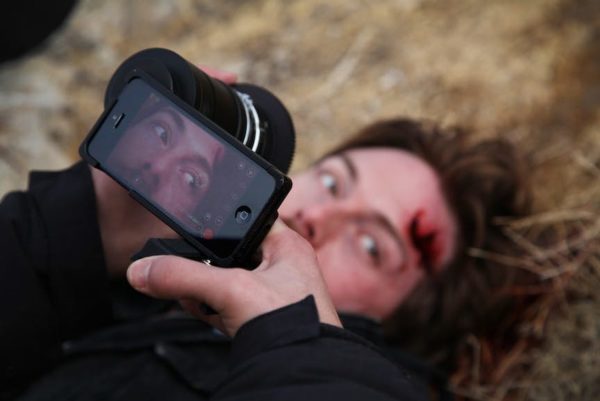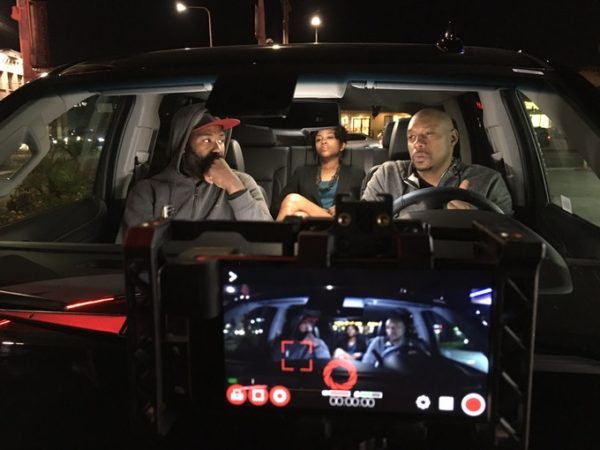Best Feature Films Shot on an iPhone (or smartphone)
If you read this blog often, you don’t need telling that smartphones can now shoot amazing quality video. If you are new to iPhone filmmaking, however, you might not realise that a number of successful full length films have been shot using mobile phones. Not only that, but some very well known directors have shot films using iPhones.
Before the main presentation, however, here are some shorts to get you warmed up.
Snow, Steam, Iron by Zack Snyder
Zack Snyder is the director of a few big budget blockbusters, including 300 Spartans, Watchmen, Legend of the Guardians, Man of Steel and Batman v Superman: Dawn of Justice. A couple of years ago he released a 4-minute short film Snow, Steam, Iron, shot on an iPhone 7+.
Snyder had stepped away from Justice League while he and his wife dealt with the death of their 20-year-old daughter, Autumn. He created Snow, Steam, Iron saying he wanted to be around family and friends and making a movie was the easiest way to do that. Daughter, Willow, helped (she’s a makeup artist).
Meanwhile, his son, Eli, brought along friends from UCLA to be set PAs. He enlisted friend Samantha Jo (who appeared in Wonder Woman) for the lead role. They shot the whole thing in a weekend, in and around Snyder’s office on the Warner Bros. lot in Los Angeles.
Here’s some cool BTS shots of the making of this short:

In this shot you can see 2 iPhones are being used at the same time. One is mounted to a camera slider on a tripod, which is also mounted using a Beastgrip. The second is handheld mounted on a smartphone gimbal.
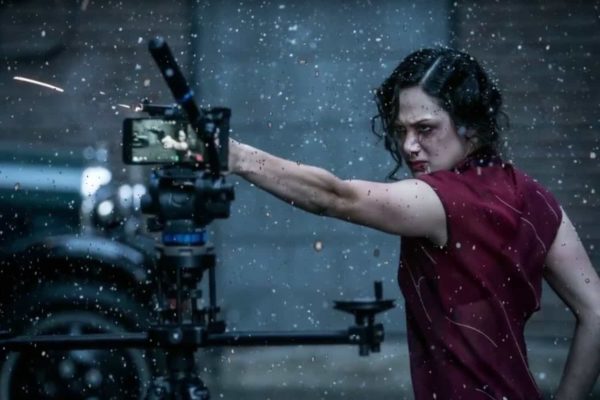
There’s that camera slider again. And this time we can see FiLMiC Pro being used.
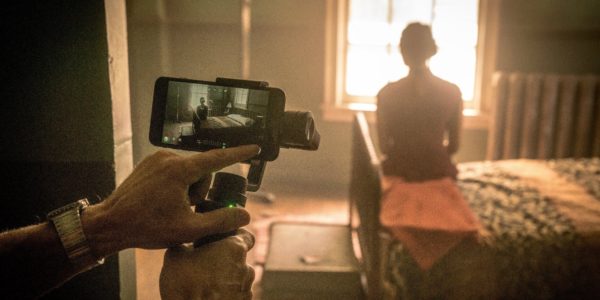
Détour by Michel Gondry
Michel Gondry is a French director, screenwriter, and producer noted for his inventive visual style and distinctive manipulation of mise en scène. He is known for directing Eternal Sunshine of the Spotless Mind, Be Kind Rewind and The Green Hornet. Plus he’s directed a number of TV show episodes, music videos and short films.
Like Snow, Steam, Iron – Détour was shot on an iPhone 7+. The story is told from the perspective of a small tricycle that falls off the back of a car. In order to reunite with its owners, the tricycle embarks on an adventure across the countryside, where it meets various amusing characters that help guide its return home.
Here’s a behind the scenes still from the making of the short.
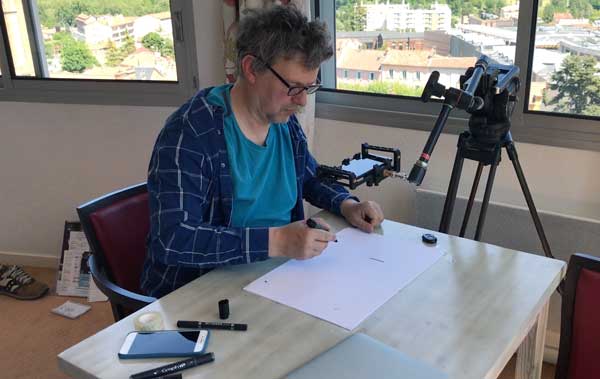
Here we can see Gondry animating some titles. The iPhone is mounted using a Beastgrip onto a hefty looking tripod.
You can watch a (very brief) video called Through The Eye of Michel Gondry here. Gondry is seen animating the titles of the film using an iPhone and talking about the process.
Snowbird by Sean Baker
After shooting his Sundance hit Tangerine (a feature film shot on iPhone 5s), Sean Baker was back behind the mobile device to helm a short film called Snowbird.
Baker teamed up with fashion label Kenzo to create a stunning short film which contains a beautiful, dreamy surreal quality worthy of Lewis Carroll. The film stars model Abbey Lee of Mad Max: Fury Road.
“I don’t see myself as a short-film director, and I’m not a commercial director,” Baker told The New York Times. “But there was something about fashion films: Because there would be a narrative and because I would be able to experiment, it was so appealing. This was the first time I was actually excited by a project I was being commissioned for.”
Here’s some nice behind the scenes photos from the shoot.
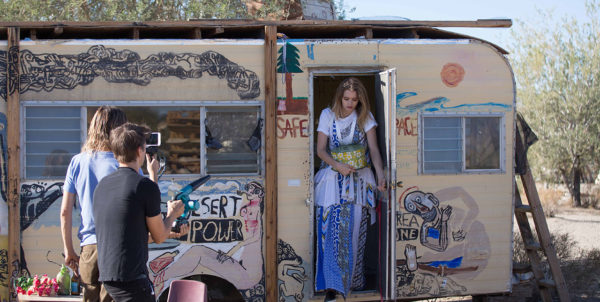
Sean Baker was working on iPhone films before motorised 3 axis gimbals became commonplace, so you can see him here using the old Steadicam Smoothee. Without a motor, those beautiful smooth shots are much harder to get when the gimbal can swing freely.
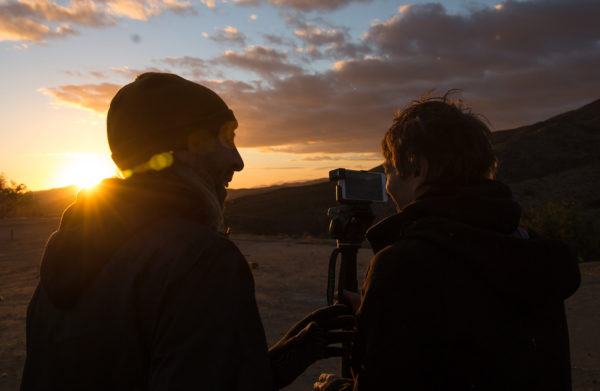
In this still you can see Sean Baker holding his iPhone 5s and I can spy a Moondog Labs anamorphic lens too. Notice too they’re shooting as the sun goes down to get that perfect twilight mood.
Of course, there’s a lot of short films shot on smartphones. We’ve already had over 60 submitted to our festival and we’ve only been open for submissions one month! But onto the full length movies shot on smartphones…
SMS Sugar Man (2008) by Aryan Kaganof
Is this the first full length film shot on a mobile phone? Does it really matter? I originally thought a film called Olive was the first, shot in 2011. But then I discovered SMS Sugar Man was made 3 years before that.
The device used was a Sony Ericsson W900i and given the sexual content contained in the film, it’s not surprising Sony didn’t champion the film at the time. The Sony Ericsson W900i was released in early 2005 and was the first in of this series to feature a graphics chip. The phone also had “above average video and camera capabilities”.
The phone had a 2MP camera, about half a GB internal memory and could shoot up to 320p resolution video. A review at the time was written by a journalist who admits he doesn’t “own a cell phone with a camera”, but goes on to describe the film:
“The entire plot of the film takes place on one Christmas Eve and director Kaganof and cinematographer Eran Tahor suffuse their scenes in yellow and red hues. The effect of this, however, is to give the film a less overall holiday feel and instead nicely gives the impression that these characters are burning in the fires that they’ve stoked for themselves.” Mike Everleth, November 17, 2008.
Kaganof himself plays the lead character. The result is true “punk” filmmaking, with very rough image quality (and plenty of sexual content). The quality is probably just below old 8mm footage and for that reason is perhaps a little hard to watch.
The full movie has been uploaded to Vimeo here:
There’s also a short “making of” movie you can watch if you want the full phone filmmaking history experience.
Olive (2011) by Hooman Khalili
This film was billed as a story about “a little girl who transforms the lives of three people without speaking one word”. There was even a Hollywood star among the cast: Gena Rowlands, an actress nominated for 2 Oscars for her work with her husband John Cassavetes. When they failed to get money from Nokia, they turned to Chris Kelly, former chief privacy officer of Facebook. And in the end they had a weighty budget of just under $500k.
The film was shot on a Nokia N8. Video shooting options were 720p @ 25fps or 720p @ 30fps.
Read More: 7 Years Ago: First Feature Film Shot on a Smartphone
You can watch the first 5 minutes here:
The film never acquired distribution and as far as I know it has never been released. So I can only judge it from the first 5 minutes here. However, we have to give it a mention simply because it’s the only film shot on a Nokia that cost half a million bucks… (or is it?). Plus, I love the early DIY smartphone filmmaking inventions, such as a drone created by taping the phone to remote control toy helicopter.
I Play with the Phrase Each Other (2013) by Jay Alvarez
Produced in the winter of 2012, I Play with the Phrase Each Other was shot on an iPhone4. As the entire film is made up of a series of interconnected phone conversations. So its a film about phone calls shot on a phone.
In style, it’s reminiscent of the Mumblecore movement. 20-to-30-somethings in the midst of existential crisis movies, talking to each other about the minutiae of their lives and feelings. Think Richard Linklater‘s first film, 1990 comedy-drama Slacker but the subtly is in the mundane.
It’s all black and white, with plenty of noise in the shadows. Considering the number of shallow depth of field shots in the film, we must assume Alvarez used some kind of cinema lens mounted to the phone. There’s telltale dark shadows clearly in the corners of some shots, which is another clue about an add on lens.
The story of how Alvarez raised money for the film is befittingly quirky. The project started when was a member of an organisation which was against forms of wireless pollution. A leader of the group commissioned him to write a screenplay about characters who die of brain cancer from their incessant use of mobile phones.
Unfortunately, the commissioner himself died in a car accident before script was completed. But Alvarez continued with the script. He later raised money to shoot the film by selling music equipment on Craigslist. Alvarez has published a video about his experience taking the film to festivals:
The film was screened at the Slamdance and Raindance film festivals.
Watch I Play with the Phrase Each Other free on YouTube
And Uneasy Lies The Mind (2014) by Ricky Fosheim
The film was shot/directed by cinematographer Ricky Fosheim and started as a Kickstarter project in 2012, raising just over $10,000 from 28 backers. Reminiscent of films such as Jacob’s Ladder, the story is told in the form of disjointed, confused memories of a character who has suffered a severe head injury.
With iPhone video now starting to compare favourably with 16mm film, the filmmakers decided to shoot the entire film using an iPhone 5. They added a TurtleJacket PentaEye lens wheel in order to shoot with Nikon Cinema Prime lenses as “conversion lenses“.
“In the middle of the lens adapter is a glass focusing screen with a patterned texture, almost like a fingerprint,” said Fosheim. “Hair, dirt, and oil from my hands would always get stuck on these focusing screens. I completely welcomed these textured imperfections and chose not to clean or replace any of the dirty parts. At times I would even add dust and dirt.”
You can see Ricky Fosheim here using his iPhone mounted onto a slider which rolls along the table for smooth dolly shots. Plus that big Nikon Cinema lens.
Watch And Uneasy Lies The Mind on Amazon
When we screened And Uneasy Lies the Mind at the Mobile Motion Film Festival, Ricky Fosheim flew over to give a great masterclass on how they went about creating the film.
You can also check out Ricky Foshmeim’s “making of” movie on YouTube here.
Tangerine (2015) by Sean Baker
When their bigger budget production failed to get off the ground, director Sean Baker took up the offer from the Duplass brothers to shoot a feature film on a micro budget. Baker says he was undecided until they tested some iPhone 5 smartphones with Moondog Labs anamorphic conversion lenses. After that, they realised it was possible to make something on such a small budget ($100,000).
“At first my Director of Photography was a little embarrassed, and I was telling him we need to embrace it or else we’ll fail. We have to create our own aesthetic. If we do that, there is no difference between 35mm and this, as long as we’re confident. When I told the Duplass Brothers, Mark was the one who patted me on the back and was like, ‘Let’s do this man, it’s like punk rock.'” Sean Baker, interview with Vice magazine.
The film was screened at Sundance, without telling the audience the film was shot on an iPhone. Only when the truth was revealed during the end credits did the audience realise what they’d just seen. The following positive reaction created a big media buzz for the film.
When we screened Tangerine at the Mobile Motion Film Festival in Zürich, Switzerland, Chris Bergoch (the film’s co-producer and co-writer) flew over to present the film. He also gave this great talk on the full story of how the film got made.
What I love about the film is that it embraces the strengths of smartphone filmmaking. The main cast had never acted in a film before, the story is improvised around their real lives and shot in locations they inhabit. This gives the film a very natural, vibrant feel. Tangerine is a documentary style “cinéma vérité” film for the era of the smartphone.
The film takes place during one day, as best friends Sin-dee and Alexandra (Kiki Rodriguez and Mya Taylor), two transgendered prostitutes, meet at a West Hollywood donut shop on Christmas Eve right after Sin-dee has been released from prison. When Alexandra informs Sin-Dee her boyfriend and pimp, Chester (The Wire’s James Ransone), has been cheating on her with a cis-gendered woman, it prompts a mad dash across Los Angeles.
9 Rides (2016) by Matthew A. Cherry
9 Rides was shot entirely on an iPhone 6s, which may be the first feature film shot using the device. Written and directed by Matthew A. Cherry, the film is about an Uber driver who clocks in to work on the busiest night of the year, New Year’s Eve. During the night, journeys across the city lead him to encounter nine different sets of passengers who help him come to terms with some life changing news.
The film stars Dorian Missick, an American actor best known for his role as Damian in the television series Six Degrees. He also voiced Victor Vance in the video game Grand Theft Auto: Vice City Stories. After shooting, the team raised over $15,000 on Kickstarter to help get the film ready for the SXSW Film Festival in 2016.
“Shooting on iPhones was an awesome experience… Without a ton of gear to lug around, we could get some interesting shots in places we couldn’t otherwise. All we had to do was mount the phones into the Beastgrip Pro and attach our lenses, like the Moondog Labs Anamorphic lens and the Beastgrip DOF Adapter with our SLR lens. FiLMiC Pro was really user-friendly and intuitive too, so shooting was a breeze.” Matthew A. Cherry interview for Beastgrip
Attaching a video camera to a car for these kind of shots couldn’t be easier than with a lightweight smartphone. Having shot a scene myself in a car using my Samsung S9, I found the process as easy as filming some friends having a chat in a car – which is pretty much what it was.
9 Rides follows perfectly the no budget school of filmmaking rule: use available locations. In this case, pretty much just a single car.
In August 2017, Matthew A Cherry went on to raise over $200,000 on Kickstarter for an animated short called Hair Love.
High Fantasy (2017) by Jenna Bass
High Fantasy is about friends on a camping trip in the wilds of South Africa who wake up and discover they have all switched bodies. The film is a “found footage” style movie, directed by Jenna Bass. This means the smartphones used to film are used by the actors as part of their performance.
When you think about it, this makes perfect sense. Any film shot in the present day or near future would be lying if it did not show everyone (main characters and background characters alike) using smartphones as a constant. Because smartphones are now everywhere, we’re photographing and filming each other constantly. One estimate says there are 14 trillion photos taken every year.
The film was was screened in the Discovery section at the 2017 Toronto International Film Festival. It also screened at the Berlinale in 2018.
“My experience of making films is that the more control I tried to have the less control I actually had.” Jenna Bass, director High Fantasy
What I found refreshing about this film is the informal style of it. It’s very raw with the camera style reflecting the way we all film ourselves now. Some shots are vertical, most horizontal, in one moment a character tells another character to stop filming. So the film itself is aware of the cameras being used.
In one shot, the camera is left running on a car dashboard while they have an argument outside the car. In that moment, I started to question why the camera was filming. Would we deliberately leave our phones filming like that? Only if we are supposed to be filming everything.
High Fantasy is not an iPhone film pretending to be a 70mm film, it is unashamedly an iPhone film. In other words, it looks like it was shot on a smartphone and doesn’t apologize for it.
High Fantasy is available on Amazon, but unfortunately only in the USA at the moment.
Here’s an interview she did about the film. I enjoy how Jenna Bass talks about the process of making High Fantasy, especially the “control is very overrated” comment.
If you can’t find a way to watch High Fantasy, the interviews are pretty interesting. Like Tangerine, High Fantasy is a film about race and gender stereotypes. The latter is probably more on the nose about it, but it still provokes an interesting discussion.
Here’s another interview, shot at Berlinale 2018, where the race and gender discussion is as awkward and revealing as the one in the film. Nothing is as black and white as it may at first seem, perhaps.
Unsane (2018) by Steven Soderbergh
Unsane is a film directed by Steven Soderbergh and written by Jonathan Bernstein and James Greer. It’s the first smartphone shot feature film made by an Oscar-winning director. The film stars Claire Foy, Joshua Leonard, Jay Pharoah, Juno Temple, Aimee Mullins, and Amy Irving, and follows a woman confined to a mental institution after she is pursued by a stalker.
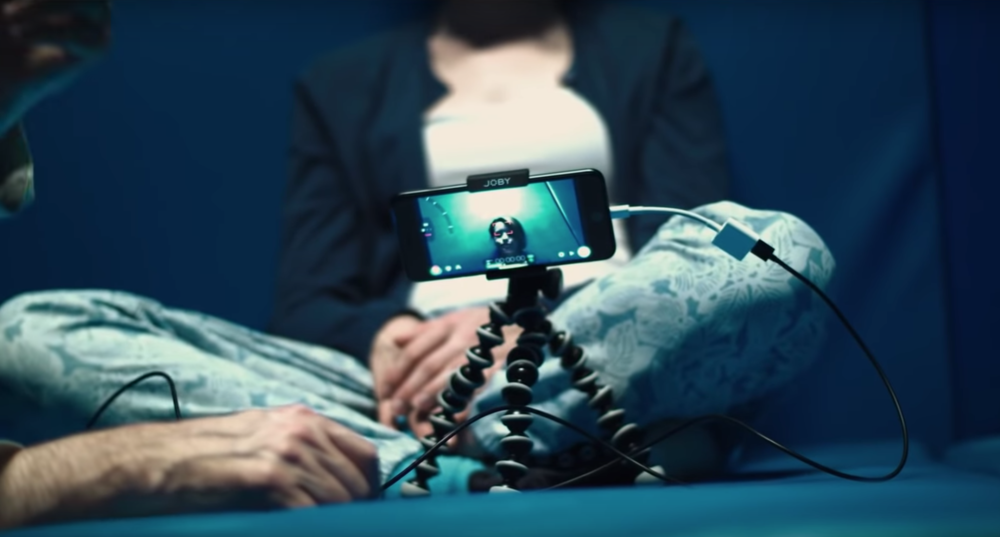
The film was shot using iPhone7 plus smartphones. Soderbergh also used many of the items we’re used to talking about on this blog. The FiLMiC Pro camera app, Moment lenses, JOBY tripods, DJI smartphone gimbal and so on.
However, one difference between Soderbergh and us is he had over $1m to spend. What did he spend it on? Knowing Hollywood ways, they probably spent $700 on the phone and $200,000 insuring it…
The film follows an unsettling “is she or isn’t she mad?” psychological thriller narrative. Again following the rules of low budget filmmaking, the story takes place in mostly one location (a mental health care centre). Perhaps reflecting Soderbergh’s fear of higher powers, the main character signs herself into the mental institution and finds she can’t get out again. Like working for Hollywood, dare we suggest?
Or buy on YouTube:
Read more: Soderbergh’s Unsane – the Making of an iPhone Film
Read more: Soderbergh’s Unsane – Behind the Scenes Insights
High Flying Bird (2019) by Steven Soderbergh
2019 saw the explosion of feature films shot on smartphones and first up was this drama set in the world of professional basketball, High Flying Bird. Yes, Steven Soderbergh had decided to shoot another one, but this time it went direct to Netflix and no theatrical release.
Not content with the meagre $1.5m he had to struggle along with shooting Unsane, and with iPhone insurance now “through the roof”, this time the Oscar-winning director demanded a cooler looking $2m.
“Is that because shooting basketball matches is expensive?” asked Netflix.
“Maybe,” replied Soderbergh.
In fact, there’s almost no actual basketball in High Flying Bird. But there are a lot of lengthy conversations regarding professional basketball, many of which I didn’t fully understand.
Shut up, it’s Soderbergh. With an iPhone (8 plus).
I have to say, the trailer rocked.
Without a doubt, High Flying Bird is the most expensive and stylish, perfectly colour graded, smartphone film ever made. I’m just not sure if it’s all that entertaining (or least moving). Rather, it’s one of Soderberg’s more cerebral musings on a David vs Goliath duel. So, instead of one woman (Unsane), this time it’s one man against an overbearing and powerful system.
Like working for Hollywood, dare we suggest?
Still worth watching though, because it shows what you can do with very little. Soderbergh is essentially using all the same kit available to us all for a few hundred dollars. And if you have trouble finding that elusive iPhone insurance for less than a couple hundred K, I can put you in touch with a guy.
Since banging out a couple of iPhone features, Soderbergh has gone on to shoot another feature, but this time back to traditional cameras. The film is called The Laundromat, about some journalists working against an overbearing, powerful system…
Read more: Shot on an iPhone High Flying Bird by Steven Soderbergh
Read more: Steven Soderbergh: High Flying Bird Reviews
Char Man (2019)
Char Man follows the “found footage” documentary style that became popular in horror movies after the success of The Blair Witch Project (1999). However, in that now 20 years old film it can be a little absurd when 16mm cameras are kept rolling even in the direst situations. But with smartphones, that all changes.
In Char Man there’s less to question there, because – as mentioned above – filming and snapping photos of our daily lives is unremarkably normal now. So what we have here is a more natural and far less strained playing out of the narrative. And when things feel more “normal” and therefore real, they often feel more scary.
“Just like Soderbergh has said, shooting with a mobile device gives you the freedom for unprecedented fast-paced filmmaking. Point and shoot.” Kipp Tribble
Hence the success of a film such as Paranormal Activity which plays off it’s low-fi set up. It’s more chilling because we are lured into suspending our disbelief when everything feels like it could be real.
The plot regards three men who set out to create a fake documentary about the Ojai Vampire. But the trio stumble across a different legend – that of the Char Man. But really, the plot is secondary to the improvised performances of the actors. Char Man succeeds very much due to the natural charisma of Jeff Kober, Kipp Tribble and Nick Greco, who underplay proceedings just enough to make this an entertaining outing, with a few chills thrown in.
Char Man is an 85 minute feature film shot in 2 1/2 days, with the filmmakers using an iPad as their “A camera” and their smartphones as their “B cameras”. Their longest shooting time in one day was 4 hours.
Read more: Making Char Man – a Horror Film Shot on Smartphones
You can also watch on YouTube:
Ones to look out for…
I’ve tried to include films it’s possible for the general public to watch (even if it’s only 5 minutes). Plus, also to give a sense of the history of using your smartphone to shoot a film, which now spans over a decade.
But as I said, 2019 has seen a bit of an explosion of smartphone-shot features. And here’s the ones we have noted:
Blue Moon (2018) by Stefan Harris
Blue Moon had its world premiere at NZIFF 2018. The film stars Mark Hadlow and Jed Brophy who stand-off in this trickily plotted thriller about a service station owner who rashly appropriates a stash of stolen drug money. All set in one budget-friendly location, the film cost around $12,000 to shoot.
Read more: Let’s just do it on a phone!
Les Plus Belles Années d’une Vie (2019)
The Best Years of a Life (English title) is a 2019 French drama film directed by Claude Lelouch. It was screened out of competition at the 2019 Cannes Film Festival. The film is a sequel to Lelouch’s Un Homme et une Femme (1966), which won 2 Academy Awards over half a century ago.
Lelouch decided to shoot with an iPhone – although reports are it was only 30% of the final film. That said, Lelouch says his next feature film is 100% iPhone.
As there’s no adjustable iris on the iPhone, moving between dark interiors to bright exteriors was tricky. Not to be defeated, DoP Maxime Héraud designed an adjustable filter with a motor and remote control. Now he could darken the filter smoothly as needed.
Read more: Oscar Winning Claude Lelouch iPhone Film Opens Cannes
Chaba-daba-da…
Midnight Traveler (2019)
Afghan director Hassan Fazili is forced to flee the country when the Taliban puts a bounty on his head.
Filmmaker Hassan Fazili and his family diaried three years and hundreds of miles while in exile from Afghanistan, after the Taliban had put out a call for his death. The film is a documentary shot on three mobile phones that Variety says “feels like a modern-day message in a bottle, an urgent appeal for help from a family that’s still searching for a home.”
Selfie (2019) by Agostino Ferrente
Selfie is a unique record of the case of 16-year-old Davide Bifolco, who was shot dead by a carabiniere in the Neapolitan district of Traiano. To understand a neighbourhood often portrayed as a ghetto and ‘Camorra’ stronghold, as well as the circumstances of Davide’s death, director Agostino Ferrente seeks out Davide’s friends and meets Pietro and Alessandro.
These last 2 films demonstrate the power of putting the camera in the hands of those with previously underrepresented voices. While documentaries are traditionally created by a trained filmmaker observing the lives of others, smartphones allow those “others” to take control of the camera and film themselves. What we hope for then is a more authentic account, rather than one open to manipulation and distortion.
Of course, no form of filmmaking is free of manipulation. But at least those who had previously lacked the education and skills to operate a camera now have a voice.
Selfie screened at the Berlinale in 2019.
Phew. I wasn’t expecting this to turn into a 4000 word article, but I think this shows how far smartphone filmmaking has come. And if the trend is anything to go by, we can certainly expect to see a lot more films shot on iPhones and other mobile devices.
Update: Smartphone Feature Films in 2020
As more and more filmmakers turn to smartphones to shoot their low budget indie films, here’s some of our favourites so far this year. Plus, there’s one notable feature which has been a hit at major festivals such as Sundance and Berlinale.
Ghost (2020)
This London-set redemption story is brought to life by deconstructing the genre conventions and infusing it with authentic characters. It’s classic British cinema but shot on an iPhone 8 using Moondog Lab’s anamorphic adapter. Inspired by do-it-yourself indie legend John Cassavetes, director Anthony Z James focuses on the the complexities of the father-son relationship, toxic masculinity and burden of responsibility.
Read our interview with Anthony Z James.
Phony (2019)
Personally, this wasn’t just one of the best smartphone films I watched last year but one of the best films, period. The film is a comedy full of surprises, and questions what is real and what is fiction in a world where everyone can now make themselves into a TV show. When we are all broadcasting ourselves constantly over social media, is there now any distinction between “real life” and movies and TV?
That’s what makes Phony so fresh. While our mainstream media continues to produce movies and TV as if we are still living in the 20th century, writer/director David Bush has made an iPhone-shot film about people filming themselves on iPhones. This is a reality we shouldn’t be able to ignore, but somehow we are.
Read our interview with writer/director David Bush.
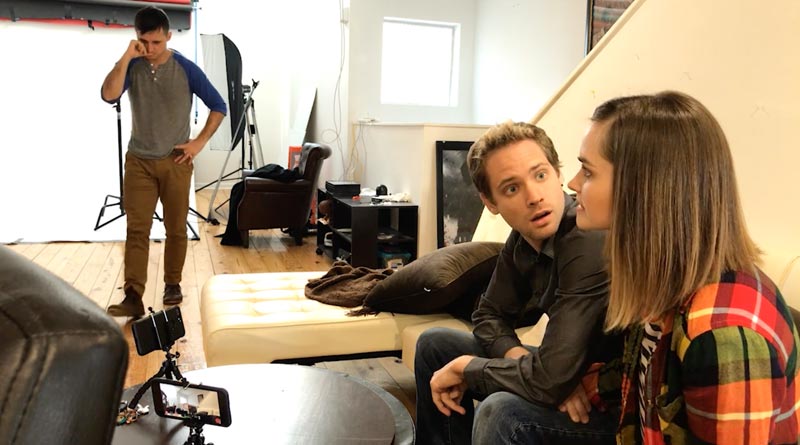
Lost In The Crowd (2019)
Heated jackets. Levitating desk lights. Barking wallets. Crowdfunding platforms like Kickstarter have seeded a virtual revolution in funding the un-fundable. But what happens to this $34 billion industry when the wheels fall off?
Shot using an iPhone, Lost in The Crowd follows the triumphs and pitfalls of three crowdfunded filmmakers seeking answers from this unregulated space. The film is funny, revealing and touching too and is written, directed and produced by professional smartphone-filmmaking advocate, Jason van Genderen.
Saudi Runaway (2020)
Saudi Runaway is a film shot on 2 smartphones, recently purchased by the company National Geographic Documentary Films. The deal was done at this year’s Berlin Film Festival (Berlinale).
The subject of the film, Muna, filmed the story herself from April to June 2019, using two smartphones, sometimes assisted by director Susanne Regina Meures. The smartphones were used as mostly hidden cameras.
With reports saying the film views as an edge-of-the-seat thriller, it perhaps demonstrates a new way of filmmaking. With smartphones relatively easy for anyone to use, the camera can be placed in the hands of the subject to tell the story their own way.
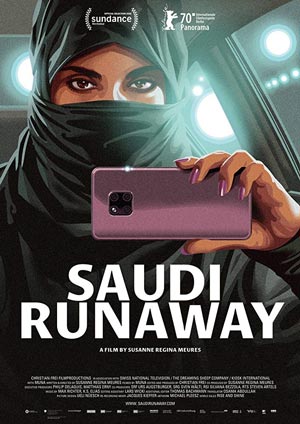
Smartphone Video – Beginner to Advanced
If you want to know more about smartphone filmmaking, my book Smartphone Videography – Beginners to Advanced is now available to download for members on Patreon. The book is 170 pages long and covers essential smartphone filmmaking topics:
Things like how to get the perfect exposure, when to use manual control, which codecs to use, HDR, how to use frame rates, lenses, shot types, stabilisation and much more. There’s also my Exploring the Film Look Guide as well as Smartphone Colour Grading.
Members can also access all 5 episodes of our smartphone shot Silent Eye series, with accompanying screenplays and making of podcasts. There’s other materials too and I will be adding more in the future.
If you want to join me there, follow this link.
Simon Horrocks
Simon Horrocks is a screenwriter & filmmaker. His debut feature THIRD CONTACT was shot on a consumer camcorder and premiered at the BFI IMAX in 2013. His shot-on-smartphones sci-fi series SILENT EYE featured on Amazon Prime. He now runs a popular Patreon page which offers online courses for beginners, customised tips and more: www.patreon.com/SilentEye


